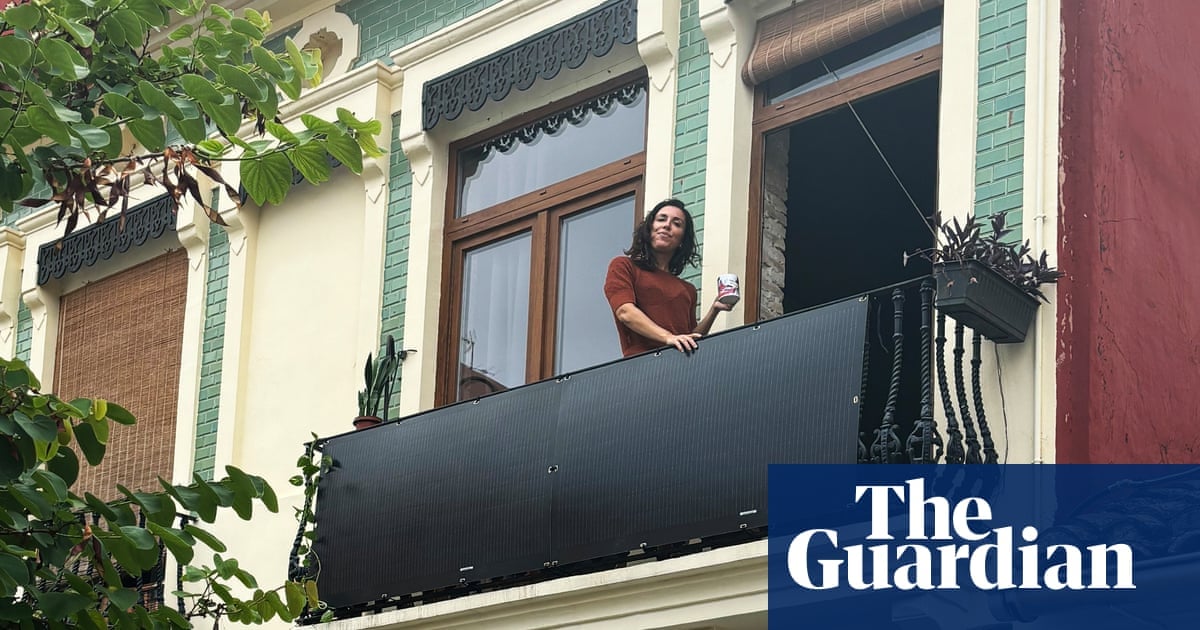This is really nice! This is the future!
I’d love to know how much they produce, especially during the winter/monthly.
In the Northern hemisphere, in Winter the Sun is at a low angle, so vertically oriented panels might produce more. As an example, I have a sunroom and at Winter’s Solstice the sunlight reaches about 3-4 meters into the room. At Summer’s Solstice there is no direct sunlight in the room, as the Sun is overhead.
Do you have any numbers :-) ?
I have a sunroom, what sort of numbers are you asking for? It’s a partly cloudy day, about 22C in the room, without heat. And about 7C outside.
Wait that’s a thing?
Holy shit that a thing!? That’s awesome!!
“Plug-in solar is part of the whole array of options,”
I don’t understand how this works? For our system we need an inverter that cost about $3000.- (half if it doesn’t have to handle a battery), and it needs to be installed by an authorized electrician.
For a small system as the one shown, the price of panels are peanuts, the 2 panels shown should cost less than $150 combined. While the cost of inverter and getting it connected is way way higher. There’s a lot more to this than not being on the roof!?! But which isn’t disclosed.The article says nothing about how the power from those panels is made usable.
There are two main inverter approaches. One big inverter that takes the DC from a bunch of panels and converts it into AC and micro inverters where each panel gets it’s own small one placed directly under the panel.
The micro inverters cost around $150 each. So you need around 10 panels before the single inverter becomes a good choice.
Installers love the micro because the install is easier. However as a owner with say 30 panels you now have 30 points of possible failure instead of the 1.
The “balcony” bit isn’t the defining characteristic, it shouldn’t be taken literally. Some people do have their “balcony solar power” on their roofs.
What defines it is limitation to 800 W and inverters that come with a normal Euro Type F (“Schuko”) plug and no legal requirement for professional installation. A layman can literally plug it in to an existing wall socket. Given that they are capped at 800 Watts, the inverters are also the simplest type and dirt cheap (although often they are literally just software-capped and identical to higher power ones, make of that what you will). Complete systems (2 panels, cabling, inverter) cost between 299€ and 800€ depending on quality. You genuinely only have to buy a fixture that suits your needs and a mate to help you install it.
Proper several-Kilowatt-systems are very expensive in Germany too.
Thanks really good info. 👍😀
A layman can literally plug it in to an existing wall socket
That’s amazing, I had no idea that is possible??? Is that special for Germany? (sorry for keeping on with new questions). 😋 I’ve never heard of that option here in Denmark.
cost between 299€ and 800€
No wonder it’s a popular option, our system is of course bigger with 11.2 kWh and 7.5 kWh battery. but it was $17000 1½ year ago. Prices have dropped to $12500 for a similar system, but still such an 800W system is dirt cheap by comparison.
There are already a few requirements for operating the balcony panels, At least here in Germany:
- You need a suitable electricity meter
- You have to register with a relevant authority and inform the electricity provider that you are operating a “balcony power plant”.
- The microconverter should run on its own secured circuit. (“Should”, will certainly do very few) But technically it is simple:
- Set up panels
- Connecting necessary plugs
- Microconverter to the socket
- Be happy that you produce up to 800 watts of your own electricity
I think it’s almost irrelevant how many panels you ultimately split up. However, no more than 800 watts may be fed in.But if you have panels with, let’s say, 2000 watts, you can of course charge various batteries with them beforehand. Nobody can say anything against it.
You need a suitable electricity meter
That makes sense, we also needed new meter, and that was about €200.- with installation. Not a big deal for a big installation, but for a system that can cost only €300.- an extra 200.- would be pretty significant.
Just for your information : belgium is allowing the balcony solar panels this year, but they have put limits on which you can install. The power supplier needs to have approved the kit you install. This is just to prevent people from getting cheap crap from the internet.
Other than that, same rules!
I had no idea that is possible??? Is that special for Germany?
I mean, the regulation seems to be, but there’s no fancy tech going on. I’m not an electrician but I think I can explain, as I have recently tried to understand myself. To understand why it’s possible it’s best to understand why the limit is at 800 W precisely.
So German wall outlets usually have a 16 A fuse and the wiring in the walls is dimensioned to accommodate slightly higher current (I think they are 2.5mm² gauge allowing up to 20 A but don’t quote me on that particular part) for safety reasons. I suppose it would be the same or very similar in Denmark, or maybe most of Europe that uses 230V/50Hz AC.
Now, normally, if you have dangerously powerful load that would melt your wires, let’s say 5 kW, and you plug it in to an outlet the fuse will just pop and you’re safe. If however you have a 2 kW PV system connected to a wall outlet nearby, it would theoretically be possible that your 5 kW load draws 13 A (3 kW) from the mains through the fuse and another 8.7 A (2 kW) from the PV system over the same wire in the wall that is only rated at 20 A but now carries 21.7 A. And the fuse would never pop at 13 A, making it a huge fire hazard. 800 W is basically just what will always comfortably fit into the safety margin of the wiring in German houses. All systems above 800 W need to be hardwired by professionals “behind” the fuse box so that every Amp from your PV goes through a typical 16 A fuse.
still such an 800W system is dirt cheap by comparison
Absolutely. I guess the low threshold for installation allows some kind of mass market economy of scale whereas systems like yours are homeowners’ luxury goods.
Great post! Thanks for doing the math and explaining the concepts!
If you pay 3000€ for an inverter then that’s probably included installing and whatnot. You can get a cheap 50€ 4kW inverter on aliexpress, or an expensive 500€ 10kW one.
No the price was not including installation, We have 11.2 kW panels and 7.5 kWh batteries. Installation was almost $5000.- !! That was probably mostly the 28 panels on the roof. But we had one installer handling everything, who was also responsible for the electrician.
That’s a massive installation though! Wow!
Also, you got a biig roof!
Have a look here: https://en.m.wikipedia.org/wiki/Balcony_solar_power
OK thanks, so they are indeed complete systems including inverter, so it can be connected to the grid.
I suppose they’ve made some cheap low power inverters then, but the power still needs to have stable voltage an frequency and synchronization. So I wonder how cheap it’s possible to make?
I also suppose it still needs an authorized electrician to connect it? Unless Germany has some fancy system that is prepared for “plug in” connection of a local power source.In the EU, as long as it’s under 800W it can be plugged directly into an outlet in your home without any kind of installation, back-feeding the grid that way.
You’re not getting paid anything for the power you send back into the grid so anything you don’t use you lose.
Still very cool, because selling surplus power is almost completely worthless anyway. (at least it is here)
In the summer when you can sell, prices are generally extremely low, we have sold about twice what we use, but the value of selling is only about 5-10% on average, compared to the savings of using it ourselves. That’s because the price often drop to close to zero in the middle of the day, and sometimes even below.
Electricity itself is dirt cheap, the reason the prices are high are transportation and taxes, and short peak prices in the evening. Here transportation alone is more than the electricity itself during winter.
And we are only paid the pure electricity price here, which I suppose is the case most places.
It literally plugs into the wall.
That’s amazing. 😀
I wonder if a whole building could use one or two inverters?
I feel that’ll make the cost reasonable
For apartment buildings I don’t think that’s possible, since electricity is a per household connection with separate meter.
For first few seconds, I deadass though they are talking about Germans with a height of 1,5 meters.
That was me.
So why won’t taller Germans get solar? I don’t even see the connection to height… Oh, maybe they hit their heads on the panels? No, that doesn’t seem likely… I don’t get it.
Only Germans this high have balcony solar
Makes sense, taller Germans throw too much of a shadow to make the solar worth it.
In b4 nimbys complain it’s an eyesore despite most people never looking up
Would be nice if grid tied inverters weren’t such a regulatory PITA. Micro-deployment solar, and more importantly distributed energy storage, makes so much sense and could solve a lot of grid-related problems.
I can tell you I have a portable solar battery for emergencies and if I need to use it the right place for the panel is in my balcony, so this makes a ton of sense. In an apartment building roof space is relatively small per unit, but at least where I am every unit has a balcony. In my case even a rear-facing balcony that doesn’t face the street but still gets sun for anywhere between 4-10 hours a day. If/when I am in a position to explore a solar installation this would be a good thing to look into.
Germans also have 7 times the power bill
I blame Bavaria. If Germany had multiple price zones like other European countries instead of one giant one prices would plummet here in the north, while they’d explode in Bavaria. The state that does not want wind power, does want nuclear power, but already knows ahead of time that its geology (with lots of mountains and granite) is unsuitable for nuclear waste storage. Meanwhile, north German wind power and Scandinavian hydro dams complement each other perfectly. The Bavarians could do the same with the Austrians, they just don’t. They want to eat cake and have it, too.
Am Bavarian can confirm. The CSU has been in power this state since forever. Especially old people just keep voting for them cause it’s the way it always was. They had to form a coalition after the last elections. Their partner is essentially the exact same party but even more right wing. Not even kidding, I could not name a single area where they differ other than their main guy apparently handed out nazi newspapers in his younger years or smth. He blamed it on his brother and then the scandal just died off.
nb4 someone laughs at us Germans for pulling out of nuclear power: No, nuclear is not cheap. It’s literally the most expensive way to generate electricity. Solar is cheap and better for the environment.
Nuclear is cheaper than your average electricity cost.
I know because I’m Swedish and you use us as your cheap electricity.
No, nuclear is not cheap. It’s literally the most expensive way to generate electricity
Source?
Beats coal anytime. Or Russian gas.
French electricity enters the chat.
Nuclear is reliable, predictable and stable 24/7 source. Solar not so much and possibly not that great for the environment if we don’t figure out what to do with used solar panels. Also their production is not exactly clean. Whereas nuclear requires a wasted fuel storage somewhere and the fuel will eventually run out of radiation in some hundreds of thousands years.
Those small balcony systems pay for them here in Germany at ~35 Cents/kWh in a few months. Even if your power bill is 7x cheaper, they will pay for themselves easily.
This article is more than 1 month old
Oh no! Quick! To the incinerator!
I am not sure 1.5m Germans all deciding on a single course of action is something to be happy about.
You have Trump now. It’d be our turn to make jokes, if we had any humour.
Nah, making fun of germans is always ok, especially now that at least 1 in 5 voters are voting for literal Nazis again in Germany.
We have passed the torch of a fascist dystopia to another country.
Oh, German=Nazi reference, how original.
A mere drop in the bucket when 77m have decided on a much worse course of action in another country.
Nearly 100 years on time to move on and focus on the ones that carried it on I think
Why? Can you explain a little bit?
*hurrdurr* Germany! Hitler! *hurrdurr*
I am not sure if you are a student of history but twice before the Germans decided to go to war and have as their foe the world.
We happily take the blame for WW2, but WW1 is on Austria!
Don’t know about “happily”. “Readily” might be more accurate.
On second thought… yeah.
And how is that related to balcony solar?
And does this have anything to do with generating power from solar panels on your own balcony?










